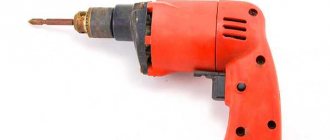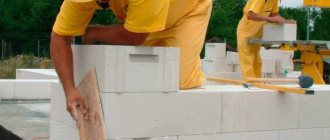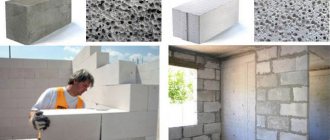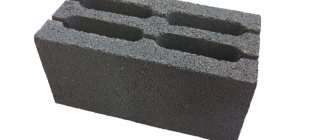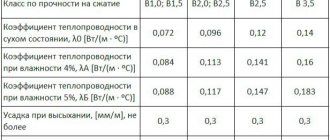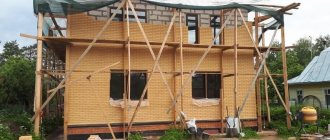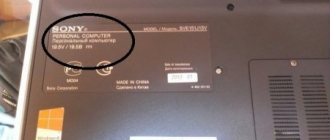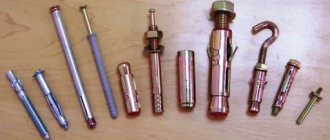- 1 Application
- 2 Aerated concrete 2.1 Advantages
- 2.2 Disadvantages
- 3.1 Benefits
The high price of building materials and the considerable cost of construction services have become the reason that today new products are gaining popularity - such as ceramic blocks or aerated concrete. Their price and properties are very similar. It is not surprising that an inexperienced person can hardly choose any of these materials, because it is important to take into account absolutely all the nuances before making a final decision. In order to figure out which of these products will be the best choice - aerated concrete or ceramic block, you should examine the main distinctive properties of both products.
Application
Builders have noticed this trend - the closer the building is to the city, the more often consumers prefer housing constructed from aerated concrete or ceramic blocks. At the same time, the further from the city, the more economical the selected material. The most budget-friendly choice is the construction of personal suburban housing from aerated concrete using wooden beams. These beams are used as floors. However, the material has a big disadvantage - it can sag during operation. What is also important is the low sound permeability of the material. At the same time, prefabricated floors, as well as monolithic ones, greatly (almost double) increase the cost of construction as a whole.
If you want to build housing with an area of up to 300 m2, aerated concrete will be the best choice. But if you are planning to build a house with a total area of more than 300 m2, then a ceramic block will be the ideal solution. We should not forget that, with equal areas, housing built from a ceramic block will cost the consumer almost 15% more, in contrast to the same aerated concrete. It should be noted that masonry using the classical method with ceramic blocks is used only for walls inside the house. More recently, ordinary brick began to lose its position; its place now belongs to the ceramic block. And this is not surprising, because one such product replaces almost 13 bricks.
Aerated concrete and ceramic materials increase the productivity of the process several times, in contrast to masonry with conventional bricks using classical technology. In addition, the pressure on the base and the volume of building material used are very noticeably reduced. It is preferable to build low-rise buildings from aerated concrete blocks, but it is recommended to build taller buildings from ceramic blocks.
Return to contents
Aerated concrete or ceramic blocks, which is better?
Most modern building materials, especially brick, for all their advantages today have a very high price, making their use inaccessible to most private developers. To the delight of many developers, the situation on the building materials market has changed for the better, with the advent of such a fundamentally new material as a porous ceramic block. Its design features and parameters are in many ways similar to gas silicate or aerated concrete blocks, but they also have some significant differences. And in order to understand which of these materials is better, you need to carefully familiarize yourself with their characteristics.
| Comparable indicators | Aerated concrete block D500 | Porous ceramic block |
| Strength grade | V 3.5 | AT 5 |
| Load bearing capacity | 50 kg/cm2. | 100 kg/cm2. |
| Thermal conductivity | 0,12 | 0.16 W/m*S |
| Soundproofing | 45 dB | 55 dB |
| Frost resistance cycles | F50 | F50 |
| Weight 1 m3 | 560 kg | 920 kg |
| Average cost m3 | 3300rub | 5100 rub. |
In general, ceramic blocks, thanks to their production technology, are distinguished by higher strength and density, and the resulting durability. In addition, they are more frost-resistant.
The density and strength of ceramic blocks up to 100 kg/cm2 allows their use in multi-story construction. But it is possible to build multi-storey buildings using aerated concrete blocks with a strength of up to 50 kg/cm2 only up to 5 floors, using reinforcing belts.
At the same time, anchor fastenings can be installed on aerated concrete blocks to fix massive structures (batteries, kitchen furniture, etc.), but it is not possible to install such fastenings on ceramic hollow blocks; it is necessary to make special inserts. In addition, ceramic blocks cannot be grooved for recessed laying of cables and pipes, while aerated concrete can easily withstand this procedure. This also affects the thickness of the plaster layer, which will need to be 2-3 cm on ceramic blocks, and up to 1 cm on an aerated concrete wall. Of course, the absolute advantage of aerated concrete is its lightness and flexibility in processing. It is easy to cut in any direction, giving it almost any shape needed at a construction site. Of course, it won’t be possible to work so easily with ceramic blocks.
Perfectly even laying of aerated concrete blocks
Gas silicate blocks of the 1st category have an ideal shape and a smooth surface, due to which they are laid using a special assembly adhesive, which can significantly reduce heat loss at the seams. Ceramic blocks are laid using ordinary cement mortar, although the number of seams and their dimensions are significantly less than when using traditional sand-lime or hollow bricks. But even when using a special heat-insulating solution, the thickness of the seams is still quite large, 5-8 mm, which of course negatively affects the thermal resistance of the walls.
Laying ceramic blocks
As mentioned earlier, ceramic blocks are much more resistant to external climatic influences. They tolerate extreme cold and heat equally well and are distinguished by the fact that they practically do not absorb moisture. This, of course, has a good effect on the resistance of the walls to external influences, but negatively from the point of view of environmental friendliness, since the vapor permeability and, accordingly, the breathability of the wall is much worse compared to aerated concrete. Walls made of aerated concrete are much more environmentally friendly than walls made of ceramic blocks, but they are also much more susceptible to moisture and frost, so it is advisable to finish them with brickwork or special facade plaster before the onset of cold weather. And of course, masonry of walls made of aerated concrete blocks, as well as ceramic ones, cannot be left in the open air for the winter. It is imperative to cover the house with a roof before the fall, otherwise direct contact with water and its freezing in winter will tear any block.
And of course, you need to remember that both aerated concrete block and ceramic block are wall materials, not facing ones, and require mandatory finishing, both inside and outside.
To learn more about construction from aerated concrete, I offer you completely free .
60 tips for building your home right now by simply writing a question on the Q&A page. >>>
Aerated concrete
This material has certain advantages when compared with other building materials.
Return to contentReturn to content
Advantages
Economical. Using these products, you can reduce the cost of housing construction, as well as reduce the number of hired workers. This also includes the fact that there is no need to purchase or rent specialized construction equipment or machinery.- High fire resistance. This material has an increased fire safety rating. Thanks to this, it can be successfully used in the construction of fire-resistant buildings.
- Environmentally friendly. Since I do not use harmful components during the manufacture of this material, it is completely non-toxic and, as a result, does not emit hazardous substances.
- Soundproofing. This product has a high sound absorption rate. It is also important that the sound will not be reflected from the walls. None of the similar construction products can boast of such a characteristic.
- Thermal insulation. If you decide to build housing from aerated concrete, you don’t have to worry about additional thermal insulation, because this material has quite high thermal efficiency.
- Strength and durability. Thanks to its manufacturing features, aerated concrete not only does not lose its properties during operation, but also increases them during use.
Return to contentReturn to content
Flaws
Due to the fact that aerated concrete blocks absorb moisture, their properties can greatly deteriorate. The result will be deformation of the product, which will negatively affect the entire decoration of the house. Due to this nuance, additional costs are required in order to isolate the blocks from moisture. The use of a special type of adhesive mixture is also very expensive, however, the use of a regular cement mixture during the construction of housing from aerated concrete blocks is prohibited.
To prevent the occurrence of cracks, which quite often happens with aerated concrete, you need a completely flat base - for this reason, a monolithic strip base is required for housing made of aerated concrete. It will help to avoid deformation in the future. If a good base is installed and all technological recommendations are fully followed, this building material will meet all its characteristics.
Return to contents
Ceramic blocks
Advantages
Environmentally friendly. This ceramic product contains only organic components such as clay and sand. The material has excellent breathability and the ability to regulate the indoor microclimate.- Strength and durability. The service life of ceramic blocks is very long. Houses built from such products can last at least a hundred years.
- Thermal efficiency. This product has a high thermal insulation rate. Thanks to this, it became possible to erect walls of a smaller thickness during construction, and this will not at all affect the comfort inside the building.
- Fire resistance. Due to its composition, ceramic block is fire resistant. It can easily withstand high temperatures, which means it is suitable for the construction of fire-resistant buildings.
- Increased strength. Ceramic blocks are not afraid of any external factors - strong wind, snowfall or downpours. And if, when constructing housing, you use reinforced concrete slabs as flooring, then such a building will become even stronger.
- Visual beauty. This material has an attractive and aesthetic appearance. There is also a huge list of various types of decoration and finishing of walls made of ceramic blocks.
Flaws
The disadvantages of ceramic materials include the fact that during installation it is necessary to strictly follow the manufacturer’s technological instructions. This means that only a special type of adhesive solution is required, and a special mesh is required to protect the voids. It is also necessary to involve only qualified specialists in construction work who already have considerable experience working with this product.
If you refuse to follow the manufacturer’s recommendations, this will negatively affect, first of all, the thermal insulation of your home. It is recommended to buy ceramic products only from trusted manufacturers, because otherwise you risk getting, instead of a high-quality material, one that will collapse during the construction process.
Return to contents
Ceramic blocks: advantages and disadvantages
To summarize, it can be noted that ceramic blocks also have their advantages and disadvantages. In many ways, they coincide with those that are characteristic of building bricks, since both of them belong to ceramic masonry materials. Porous ceramic blocks are made from natural clay with the addition of mineral and organic components that are needed to improve their basic properties. This means that the main advantage of this material is its environmental friendliness.
As for pores, they are formed during the firing process when the raw material burns out. Thus, ceramic blocks retain all the advantages of traditional ceramics, but at the same time have improved thermal conductivity.
The advantages of this material include the following:
- Light weight with fairly significant geometric dimensions.
- A wide selection of shaped elements that can be used to create corners, lintels, and other structures of complex shapes.
- High thermal insulation characteristics, which allow the construction of single-layer walls from 44 cm thick blocks. In the future, such structures will not require insulation: such walls have good thermal inertia, that is, they accumulate heat quite quickly, but release it slowly.
- The use of warm blocks allows you to speed up and simplify the construction process.
- The blocks are fastened using a tongue-and-groove system, which minimizes heat loss through masonry joints. In addition, thanks to this technology, you can save on masonry mortar.
A warm porous ceramic block has lower sound insulation characteristics than solid ceramic bricks, but they are still quite high. The disadvantages of this material include the fragility of its internal structure, which leads to an increase in time and money during loading and unloading operations, transportation and storage. The peculiarity of this material also lies in the fact that it can quite actively absorb moisture, which means additional costs for waterproofing when constructing structures from it. In addition, ceramic blocks can absorb moisture during storage, so they cannot be stored outdoors. Finally, ceramic blocks require additional finishing, and this is another difference from aerated concrete.
Key Similarities
The large size and porosity of the blocks are the main similarities between the blocks.
Ceramic blocks and aerated concrete are similar mainly in that these materials are porous and large in size. Another common feature is that both are used in construction with equal frequency. Their differences lie in the components from which they are made. Aerated concrete blocks are artificially created building products and are a subtype of cellular concrete. Ceramic blocks are a completely organic material, because they are made from clay.
There are differences between the two building materials in terms of waterproofing. It is the ceramic block that has a higher indicator, and therefore it is stronger, and therefore, at least for that reason, better than aerated concrete. Although there is no consensus on which is better. Both building products have a high sound insulation rate, and it is much higher than that of the same classic brick.
Return to contents
Comfort at home
- Ceramic block has the property of both absorbing moisture and releasing it. Thus, humidity regulation occurs in the house without devices and systems. Due to their high inertia, ceramic blocks have a heat capacity higher than that of a gas block. This means that in winter the ceramic material gains heat and then slowly releases it into the premises, thereby controlling a comfortable temperature in the house. And in summer the situation is the opposite - warm ceramics accumulate cool air in their voids, preventing warm air from filling the interior spaces. This allows you to save on heating and air conditioning at home in different seasons.
- The gas block gives off moisture for years and does not have such properties.
A house made of ceramic blocks is also more suitable if you have allergies in your family. This is due to the absolute hypoallergenicity of the blocks. Gas silicate contains dust emissions, which must be kept in mind.
Main quality features
- Aerated concrete and ceramic blocks can be used both for the construction of internal walls and partitions, and for the construction of external ones.
- Unlike similar building materials, these two have a minimal number of defective products.
- In the process of work, there is a significant saving in consumables.
- Both materials have an ideal geometric shape.
- The products have a special cellular structure, as a result of which the pressure on the base is less than that of other construction products.
- Special tongue-and-groove system.
- Smooth surface of the constructed walls.
- High productivity due to the size of the materials.
Return to contents
Ceramic blocks: characteristics, pros and cons
Warm ceramics are made from a mixture of clay and materials that burn out during the firing procedure, forming sealed voids filled with air. The material has good thermal insulation parameters, is practical and easy to install thanks to the tongue-and-groove method of connecting elements.
Advantages of ceramic modules:
- the total weight of a building made of ceramic blocks is quite small, which makes it possible to equip a simple, non-reinforced foundation;
- the cost of the project is reduced due to the saving of mortar that is unnecessary for making vertical joints;
- tongue-and-groove system and large block sizes ensure quick construction;
- the heat and sound insulation characteristics of the products make it possible to avoid additional thermal insulation of the internal partitions of the house;
- the plaster mixture is required 2.5 times less than when processing the same area of brick walls;
- ceramic blocks are resistant to the harmful effects of aggressive environments, which extends the service life of the object (up to 120 years);
- clay is a natural, environmentally friendly material, so the microclimate in homes made of warm ceramics is comfortable and hypoallergenic.
Disadvantages of ceramic modules:
- During construction, it is important to observe all the nuances of the technological process, otherwise there is a high risk of masonry defects;
- The blocks are quite fragile and are easily destroyed if handled carelessly.
Features of masonry materials
A level foundation and its waterproofing are necessary conditions for construction from expanded clay concrete and aerated concrete.
To lay any of these products, you need a flat base, as well as its thorough waterproofing.- The width of the internal walls must be at least 25 centimeters, but in the case of external walls this figure must be at least 37.5 centimeters.
- When laying both types of blocks, it is necessary to use a special type of adhesive solution. All edges of the block, as well as all seams, must be carefully covered with glue. The technology for preparing glue and its proportions can be found in the manufacturer's instructions.
- If necessary, aerated concrete can be cut with the most ordinary hacksaw. But ceramic blocks can be sawed using diamond wheels. Before cutting, any of the blocks should be installed in a convenient and level place. It is not recommended to apply too much pressure on the tool.
- When the last block in the row has been installed, it is imperative to check the evenness of the masonry using a horizontal method. If differences and unevenness appear, this is fraught with the appearance of cracks on the wall in the future.
- If the masonry was carried out in strict accordance with all technological instructions, then after a period of drying the wall, the blocks cannot be separated from each other.
Return to contents
